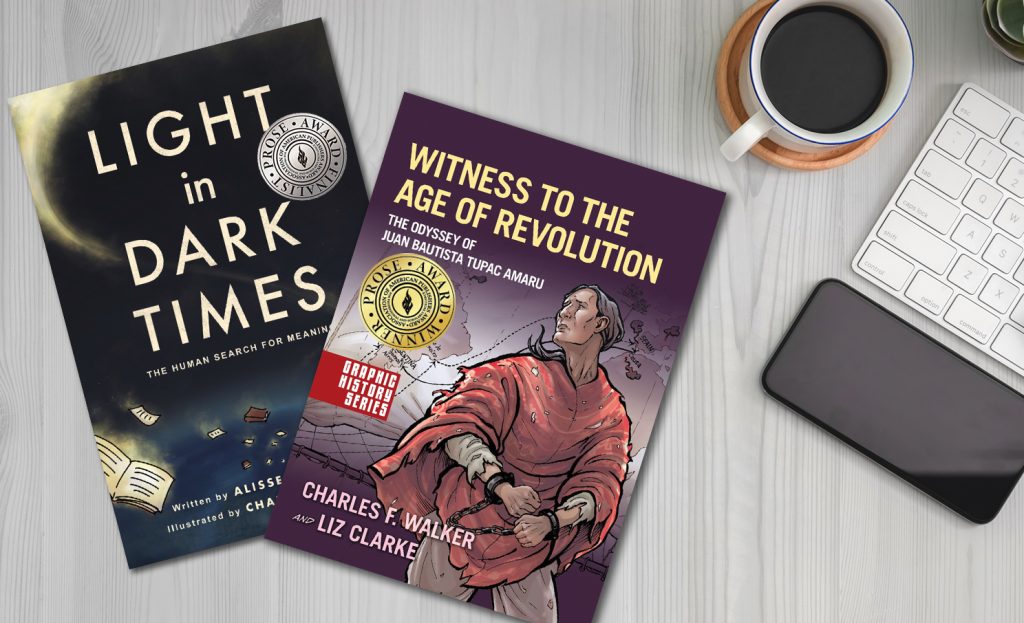November 2, 2021
A League of Their Own: Non-Fiction Graphic Novels

When was the last time you read a graphic novel? And when you think of them, do you think of Garfield and Calvin and Hobbes, Batman and Superman, or webcomics like xkcd?
While many people associate graphic novels or graphic narratives with comics, the truth is that these robust works are often used to explore a wide range of complex topics, including scholarly analysis of historical events, educational materials related to science and medicines, memoirs, and biographies. Although scholarly graphic novels frequently tackle the same serious subjects that are found in traditional books, readers engage with them a different way.
In fact, Graphic narratives are often used in educational settings as a way of encouraging reluctant readers. They’re usually seen as fun, especially to those who view reading a book as onerous. But it would be a mistake to say that these works are ‘simple’ when compared to text driven publications. On the contrary, by using a combination of visual and verbal communication, these works are quite complex, simultaneously engaging multiple literacies. As a result, they can be used to convey information or emotion more effectively to the reader.
Recognizing the growing importance of graphic novels, last year the Association of American Publishers created the Nonfiction Graphic Novels category for the annual PROSE Awards. This category recognizes the creativity and innovation in publishing graphic narratives and showcases the best of the genre.
Judging from the submissions we received for the 2021 PROSE Awards, the first year with the Nonfiction Graphic Novels category, publishers are making good use of the format. One great example is Witness to the Age of Revolution: The Odyssey of Juan Bautista Tupac Amaru, published by Oxford University Press and authored by Charles F. Walker and Liz Clarke, which won the category last year. Part of OUP’s Graphic History series, the work follows the life of Juan Bautista Tupac Amaru, from his participation in the unsuccessful Tupac Amaru Rebellion in the Peruvian Andes, through his imprisonment following the revolution, brutal forced travel, first across the Andes and then across the Atlantic, and eventual release and return to South America decades later.
Chronicling the experiences of Bautista, Walker and Clarke engage the reader through a hybrid approach of nontraditional narrative of the Age of Revolution, filled with highly detailed illustrations, followed by a traditional narrative with additional details of the same story, and then primary sources. Witness to the Age of Revolution is well researched and structured in such a way that it nearly writes itself into a course syllabus.

As a librarian who often advocates for the use of graphic narratives in college classrooms, I like to refer to them as “sneaky vegetables”: students are often excited and, anecdotally, say they are more likely to read the graphic narrative on the syllabus. Even though they think of it as fun reading, they still engage with the material in a meaningful way.
While works like Witness to the Age of Revolution lend themselves well to classroom use, graphic narratives are not valued simply for their educational uses. The 2021 PROSE finalist, Light in Dark Times: The Human Search for Meaning, published by University of Toronto Press and authored by Alisse Waterson and illustrated by Charlotte Corden, brings together art and anthropology and asks the reader to reflect on their place and purpose in the in the world at this moment. Part of University of Toronto Press’ ethnoGRAPHIC series, the work is based on Waterson’s 2017 speech at the American Anthropological Association’s annual conference, the work offers those not present for the address the opportunity to engage with the work in a different way – in the graphic narrative, the reader is able to join Corden and Waterson, traveling together through space and time to meet more than a dozen writers and activists and engage in conversation with them, while presenting a call for action to create a new future.
I love graphic narratives because they’re fun, but also because they challenge me to engage with material I might not otherwise read. I’m excited to learn from this year’s submissions.
